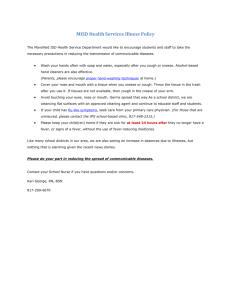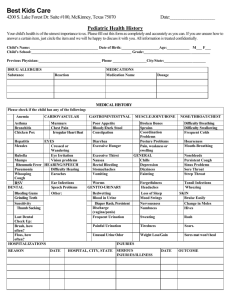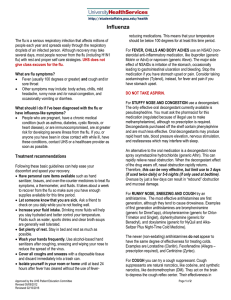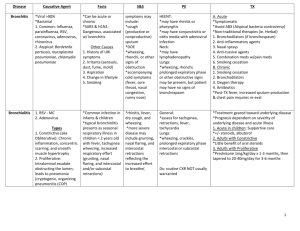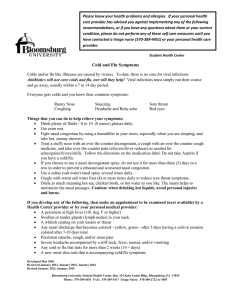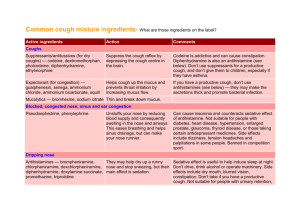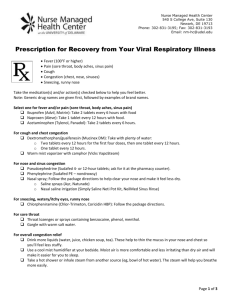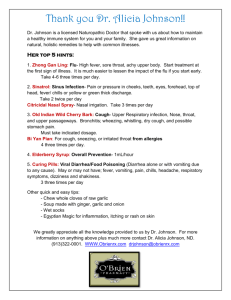Upper Respiratory Infections Types of Upper Respiratory Infections
advertisement
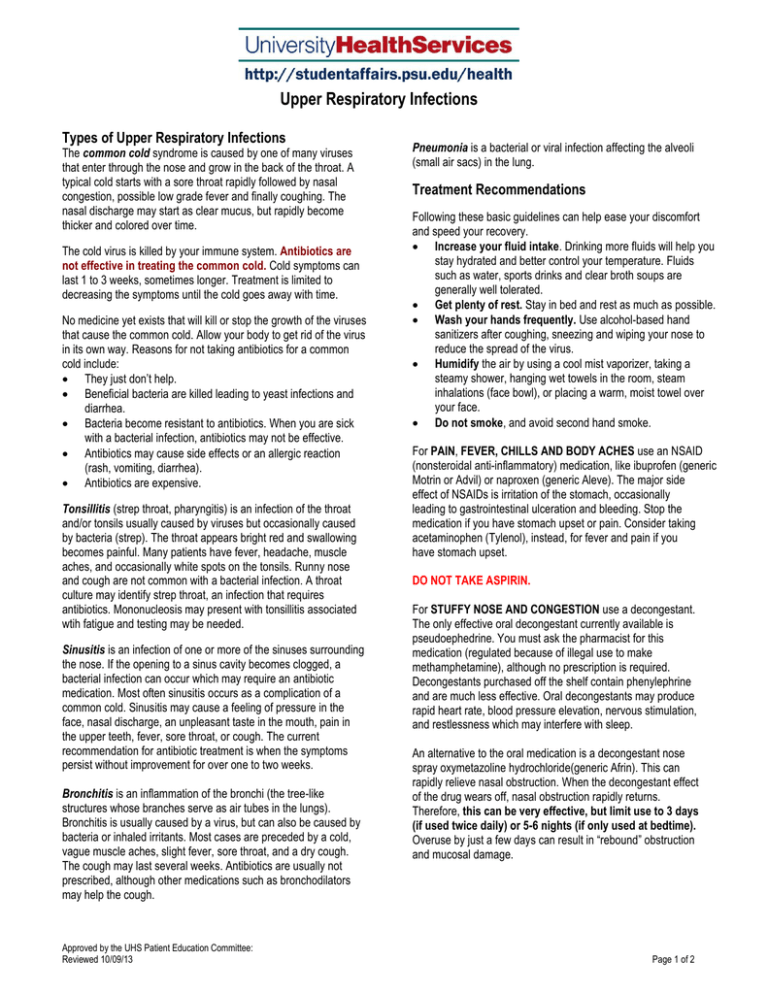
Upper Respiratory Infections Types of Upper Respiratory Infections The common cold syndrome is caused by one of many viruses that enter through the nose and grow in the back of the throat. A typical cold starts with a sore throat rapidly followed by nasal congestion, possible low grade fever and finally coughing. The nasal discharge may start as clear mucus, but rapidly become thicker and colored over time. The cold virus is killed by your immune system. Antibiotics are not effective in treating the common cold. Cold symptoms can last 1 to 3 weeks, sometimes longer. Treatment is limited to decreasing the symptoms until the cold goes away with time. No medicine yet exists that will kill or stop the growth of the viruses that cause the common cold. Allow your body to get rid of the virus in its own way. Reasons for not taking antibiotics for a common cold include: They just don’t help. Beneficial bacteria are killed leading to yeast infections and diarrhea. Bacteria become resistant to antibiotics. When you are sick with a bacterial infection, antibiotics may not be effective. Antibiotics may cause side effects or an allergic reaction (rash, vomiting, diarrhea). Antibiotics are expensive. Tonsillitis (strep throat, pharyngitis) is an infection of the throat and/or tonsils usually caused by viruses but occasionally caused by bacteria (strep). The throat appears bright red and swallowing becomes painful. Many patients have fever, headache, muscle aches, and occasionally white spots on the tonsils. Runny nose and cough are not common with a bacterial infection. A throat culture may identify strep throat, an infection that requires antibiotics. Mononucleosis may present with tonsillitis associated wtih fatigue and testing may be needed. Sinusitis is an infection of one or more of the sinuses surrounding the nose. If the opening to a sinus cavity becomes clogged, a bacterial infection can occur which may require an antibiotic medication. Most often sinusitis occurs as a complication of a common cold. Sinusitis may cause a feeling of pressure in the face, nasal discharge, an unpleasant taste in the mouth, pain in the upper teeth, fever, sore throat, or cough. The current recommendation for antibiotic treatment is when the symptoms persist without improvement for over one to two weeks. Bronchitis is an inflammation of the bronchi (the tree-like structures whose branches serve as air tubes in the lungs). Bronchitis is usually caused by a virus, but can also be caused by bacteria or inhaled irritants. Most cases are preceded by a cold, vague muscle aches, slight fever, sore throat, and a dry cough. The cough may last several weeks. Antibiotics are usually not prescribed, although other medications such as bronchodilators may help the cough. Approved by the UHS Patient Education Committee: Reviewed 10/09/13 Pneumonia is a bacterial or viral infection affecting the alveoli (small air sacs) in the lung. Treatment Recommendations Following these basic guidelines can help ease your discomfort and speed your recovery. Increase your fluid intake. Drinking more fluids will help you stay hydrated and better control your temperature. Fluids such as water, sports drinks and clear broth soups are generally well tolerated. Get plenty of rest. Stay in bed and rest as much as possible. Wash your hands frequently. Use alcohol-based hand sanitizers after coughing, sneezing and wiping your nose to reduce the spread of the virus. Humidify the air by using a cool mist vaporizer, taking a steamy shower, hanging wet towels in the room, steam inhalations (face bowl), or placing a warm, moist towel over your face. Do not smoke, and avoid second hand smoke. For PAIN, FEVER, CHILLS AND BODY ACHES use an NSAID (nonsteroidal anti-inflammatory) medication, like ibuprofen (generic Motrin or Advil) or naproxen (generic Aleve). The major side effect of NSAIDs is irritation of the stomach, occasionally leading to gastrointestinal ulceration and bleeding. Stop the medication if you have stomach upset or pain. Consider taking acetaminophen (Tylenol), instead, for fever and pain if you have stomach upset. DO NOT TAKE ASPIRIN. For STUFFY NOSE AND CONGESTION use a decongestant. The only effective oral decongestant currently available is pseudoephedrine. You must ask the pharmacist for this medication (regulated because of illegal use to make methamphetamine), although no prescription is required. Decongestants purchased off the shelf contain phenylephrine and are much less effective. Oral decongestants may produce rapid heart rate, blood pressure elevation, nervous stimulation, and restlessness which may interfere with sleep. An alternative to the oral medication is a decongestant nose spray oxymetazoline hydrochloride(generic Afrin). This can rapidly relieve nasal obstruction. When the decongestant effect of the drug wears off, nasal obstruction rapidly returns. Therefore, this can be very effective, but limit use to 3 days (if used twice daily) or 5-6 nights (if only used at bedtime). Overuse by just a few days can result in “rebound” obstruction and mucosal damage. Page 1 of 2 Upper Respiratory Infections For RUNNY NOSE, SNEEZING AND COUGH try an antihistamine. The most effective antihistamines are first generation, although they tend to cause drowsiness. Examples of first generation antihistamines are brompheniramine (generic for DimeTapp), *chlorpheniramine (generic for Chlor-Trimeton and Singlet), *diphenhydramine (generic for Benadryl), and *doxylamine (generic for NyQuil and Alka-Seltzer Plus Night-Time Cold Medicine). The newer (non-sedating) antihistamines do not appear to have the same degree of effectiveness for treating colds. Examples are *loratadine (Claritin), *fexofenadine (Allegra), and *cetirizine (Zyrtec). For COUGH you can try a cough suppressant. Cough suppressants are natural narcotics, like codeine, and synthetic narcotics, like dextromethorphan (DM). They act on the brain to depress the cough reflex center. Their effectiveness in patients with chronic cough has been demonstrated in controlled studies but there is little published information on their effectiveness in coughs associated with colds. Cough suppressants can produce gastrointestinal discomfort but otherwise have few side effects. In normal healthy people with good cough reflexes, cough suppressants are safe. Drug interactions may occur with DM and certain antidepressants. If you are on an antidepressant, discuss this with your provider. For SORE THROAT AND NASAL CONGESTION consider using a saline rinse. Various nasal saline rinse kits are available commercially or you can make your own saline by mixing ½ teaspoon of salt and 8 ounces of warm water in a clean container: For the nose: Place the above mixture in a reusable sinus rinse bottle or draw up into a nasal bulb syringe. The most convenient way to perform a sinus rinse is in the shower or over a sink. For the throat: Swish and spit Keeping a throat lozenge, cough drop, or hard candy in your mouth will stimulate your saliva and help soothe your throat. *Available over-the-counter at the UHS Pharmacy Call the UHS advice nurse at (814) 863-4463 if any of the following happens: Temperature over 102 degrees F persists Severe headache Increased facial swelling Very large neck glands Painful joints Skin rash Chest pain Shortness of breath Difficulty swallowing own saliva Persistent vomiting Blurred vision Persistent greenish nasal discharge Foul odor to breath In an emergency go to Mount Nittany Medical Center or call 911 for an ambulance. Test Results and Advice Nurse Send secure message to advice nurse via the UHS website or call 814- 863-4463. Appointments Appointments can be made online via the UHS website, by phone 814-863-0774, or in person. If you are unable to keep your appointment, please call or go online to cancel. Otherwise you will be charged for the visit. This content is reviewed periodically and is subject to change as new health information becomes available. This information is intended to inform and educate and is not a replacement for medical evaluation, advice, diagnosis or treatment by a healthcare professional. Approved by the UHS Patient Education Committee: Reviewed 10/09/13 Page 2 of 2

